Liyan Xie
Recurrent Neural Goodness-of-Fit Test for Time Series
Oct 17, 2024



Abstract:Time series data are crucial across diverse domains such as finance and healthcare, where accurate forecasting and decision-making rely on advanced modeling techniques. While generative models have shown great promise in capturing the intricate dynamics inherent in time series, evaluating their performance remains a major challenge. Traditional evaluation metrics fall short due to the temporal dependencies and potential high dimensionality of the features. In this paper, we propose the REcurrent NeurAL (RENAL) Goodness-of-Fit test, a novel and statistically rigorous framework for evaluating generative time series models. By leveraging recurrent neural networks, we transform the time series into conditionally independent data pairs, enabling the application of a chi-square-based goodness-of-fit test to the temporal dependencies within the data. This approach offers a robust, theoretically grounded solution for assessing the quality of generative models, particularly in settings with limited time sequences. We demonstrate the efficacy of our method across both synthetic and real-world datasets, outperforming existing methods in terms of reliability and accuracy. Our method fills a critical gap in the evaluation of time series generative models, offering a tool that is both practical and adaptable to high-stakes applications.
Transfer Learning for Diffusion Models
May 28, 2024Abstract:Diffusion models, a specific type of generative model, have achieved unprecedented performance in recent years and consistently produce high-quality synthetic samples. A critical prerequisite for their notable success lies in the presence of a substantial number of training samples, which can be impractical in real-world applications due to high collection costs or associated risks. Consequently, various finetuning and regularization approaches have been proposed to transfer knowledge from existing pre-trained models to specific target domains with limited data. This paper introduces the Transfer Guided Diffusion Process (TGDP), a novel approach distinct from conventional finetuning and regularization methods. We prove that the optimal diffusion model for the target domain integrates pre-trained diffusion models on the source domain with additional guidance from a domain classifier. We further extend TGDP to a conditional version for modeling the joint distribution of data and its corresponding labels, together with two additional regularization terms to enhance the model performance. We validate the effectiveness of TGDP on Gaussian mixture simulations and on real electrocardiogram (ECG) datasets.
$e^{\text{RPCA}}$: Robust Principal Component Analysis for Exponential Family Distributions
Oct 30, 2023Abstract:Robust Principal Component Analysis (RPCA) is a widely used method for recovering low-rank structure from data matrices corrupted by significant and sparse outliers. These corruptions may arise from occlusions, malicious tampering, or other causes for anomalies, and the joint identification of such corruptions with low-rank background is critical for process monitoring and diagnosis. However, existing RPCA methods and their extensions largely do not account for the underlying probabilistic distribution for the data matrices, which in many applications are known and can be highly non-Gaussian. We thus propose a new method called Robust Principal Component Analysis for Exponential Family distributions ($e^{\text{RPCA}}$), which can perform the desired decomposition into low-rank and sparse matrices when such a distribution falls within the exponential family. We present a novel alternating direction method of multiplier optimization algorithm for efficient $e^{\text{RPCA}}$ decomposition. The effectiveness of $e^{\text{RPCA}}$ is then demonstrated in two applications: the first for steel sheet defect detection, and the second for crime activity monitoring in the Atlanta metropolitan area.
MissDiff: Training Diffusion Models on Tabular Data with Missing Values
Jul 02, 2023Abstract:The diffusion model has shown remarkable performance in modeling data distributions and synthesizing data. However, the vanilla diffusion model requires complete or fully observed data for training. Incomplete data is a common issue in various real-world applications, including healthcare and finance, particularly when dealing with tabular datasets. This work presents a unified and principled diffusion-based framework for learning from data with missing values under various missing mechanisms. We first observe that the widely adopted "impute-then-generate" pipeline may lead to a biased learning objective. Then we propose to mask the regression loss of Denoising Score Matching in the training phase. We prove the proposed method is consistent in learning the score of data distributions, and the proposed training objective serves as an upper bound for the negative likelihood in certain cases. The proposed framework is evaluated on multiple tabular datasets using realistic and efficacious metrics and is demonstrated to outperform state-of-the-art diffusion model on tabular data with "impute-then-generate" pipeline by a large margin.
Neural Differential Recurrent Neural Network with Adaptive Time Steps
Jun 02, 2023



Abstract:The neural Ordinary Differential Equation (ODE) model has shown success in learning complex continuous-time processes from observations on discrete time stamps. In this work, we consider the modeling and forecasting of time series data that are non-stationary and may have sharp changes like spikes. We propose an RNN-based model, called RNN-ODE-Adap, that uses a neural ODE to represent the time development of the hidden states, and we adaptively select time steps based on the steepness of changes of the data over time so as to train the model more efficiently for the "spike-like" time series. Theoretically, RNN-ODE-Adap yields provably a consistent estimation of the intensity function for the Hawkes-type time series data. We also provide an approximation analysis of the RNN-ODE model showing the benefit of adaptive steps. The proposed model is demonstrated to achieve higher prediction accuracy with reduced computational cost on simulated dynamic system data and point process data and on a real electrocardiography dataset.
Improving Adversarial Robustness by Contrastive Guided Diffusion Process
Oct 18, 2022



Abstract:Synthetic data generation has become an emerging tool to help improve the adversarial robustness in classification tasks since robust learning requires a significantly larger amount of training samples compared with standard classification tasks. Among various deep generative models, the diffusion model has been shown to produce high-quality synthetic images and has achieved good performance in improving the adversarial robustness. However, diffusion-type methods are typically slow in data generation as compared with other generative models. Although different acceleration techniques have been proposed recently, it is also of great importance to study how to improve the sample efficiency of generated data for the downstream task. In this paper, we first analyze the optimality condition of synthetic distribution for achieving non-trivial robust accuracy. We show that enhancing the distinguishability among the generated data is critical for improving adversarial robustness. Thus, we propose the Contrastive-Guided Diffusion Process (Contrastive-DP), which adopts the contrastive loss to guide the diffusion model in data generation. We verify our theoretical results using simulations and demonstrate the good performance of Contrastive-DP on image datasets.
Generalizing to Unseen Domains with Wasserstein Distributional Robustness under Limited Source Knowledge
Jul 11, 2022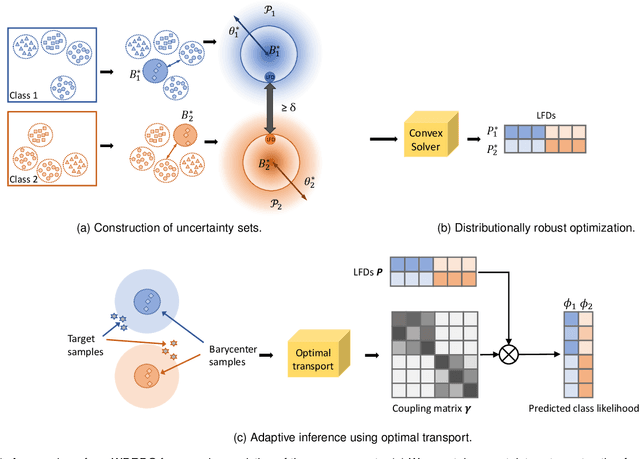

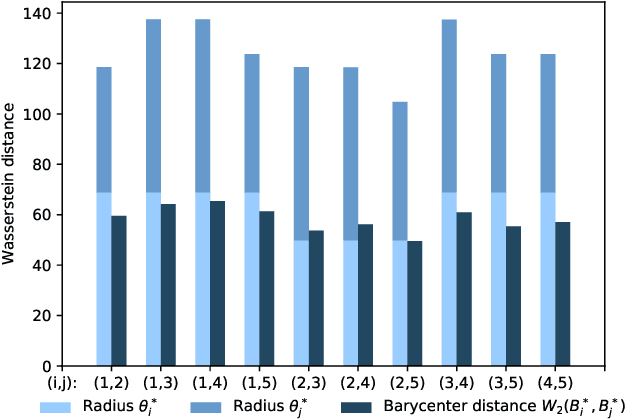

Abstract:Domain generalization aims at learning a universal model that performs well on unseen target domains, incorporating knowledge from multiple source domains. In this research, we consider the scenario where different domain shifts occur among conditional distributions of different classes across domains. When labeled samples in the source domains are limited, existing approaches are not sufficiently robust. To address this problem, we propose a novel domain generalization framework called Wasserstein Distributionally Robust Domain Generalization (WDRDG), inspired by the concept of distributionally robust optimization. We encourage robustness over conditional distributions within class-specific Wasserstein uncertainty sets and optimize the worst-case performance of a classifier over these uncertainty sets. We further develop a test-time adaptation module leveraging optimal transport to quantify the relationship between the unseen target domain and source domains to make adaptive inference for target data. Experiments on the Rotated MNIST, PACS and the VLCS datasets demonstrate that our method could effectively balance the robustness and discriminability in challenging generalization scenarios.
PERCEPT: a new online change-point detection method using topological data analysis
Mar 08, 2022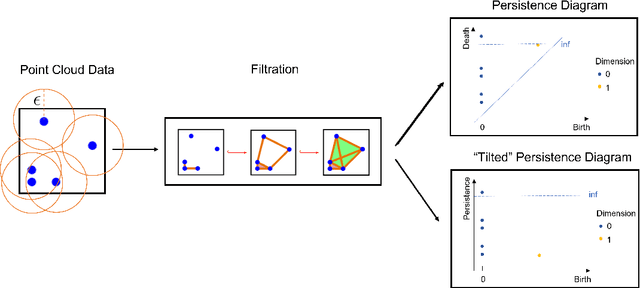
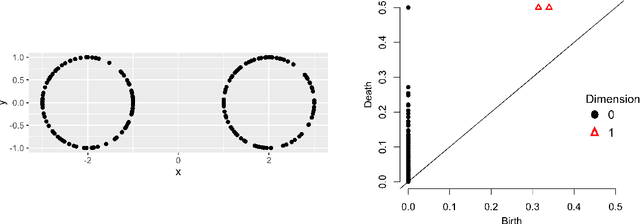
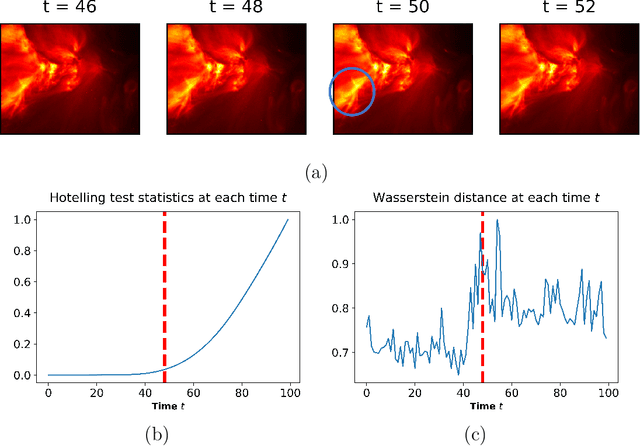

Abstract:Topological data analysis (TDA) provides a set of data analysis tools for extracting embedded topological structures from complex high-dimensional datasets. In recent years, TDA has been a rapidly growing field which has found success in a wide range of applications, including signal processing, neuroscience and network analysis. In these applications, the online detection of changes is of crucial importance, but this can be highly challenging since such changes often occur in a low-dimensional embedding within high-dimensional data streams. We thus propose a new method, called PERsistence diagram-based ChangE-PoinT detection (PERCEPT), which leverages the learned topological structure from TDA to sequentially detect changes. PERCEPT follows two key steps: it first learns the embedded topology as a point cloud via persistence diagrams, then applies a non-parametric monitoring approach for detecting changes in the resulting point cloud distributions. This yields a non-parametric, topology-aware framework which can efficiently detect online changes from high-dimensional data streams. We investigate the effectiveness of PERCEPT over existing methods in a suite of numerical experiments where the data streams have an embedded topological structure. We then demonstrate the usefulness of PERCEPT in two applications in solar flare monitoring and human gesture detection.
Class-conditioned Domain Generalization via Wasserstein Distributional Robust Optimization
Sep 08, 2021


Abstract:Given multiple source domains, domain generalization aims at learning a universal model that performs well on any unseen but related target domain. In this work, we focus on the domain generalization scenario where domain shifts occur among class-conditional distributions of different domains. Existing approaches are not sufficiently robust when the variation of conditional distributions given the same class is large. In this work, we extend the concept of distributional robust optimization to solve the class-conditional domain generalization problem. Our approach optimizes the worst-case performance of a classifier over class-conditional distributions within a Wasserstein ball centered around the barycenter of the source conditional distributions. We also propose an iterative algorithm for learning the optimal radius of the Wasserstein balls automatically. Experiments show that the proposed framework has better performance on unseen target domain than approaches without domain generalization.
Early Detection of COVID-19 Hotspots Using Spatio-Temporal Data
May 31, 2021



Abstract:Recently, the Centers for Disease Control and Prevention (CDC) has worked with other federal agencies to identify counties with increasing coronavirus disease 2019 (COVID-19) incidence (hotspots) and offers support to local health departments to limit the spread of the disease. Understanding the spatio-temporal dynamics of hotspot events is of great importance to support policy decisions and prevent large-scale outbreaks. This paper presents a spatio-temporal Bayesian framework for early detection of COVID-19 hotspots (at the county level) in the United States. We assume both the observed number of cases and hotspots depend on a class of latent random variables, which encode the underlying spatio-temporal dynamics of the transmission of COVID-19. Such latent variables follow a zero-mean Gaussian process, whose covariance is specified by a non-stationary kernel function. The most salient feature of our kernel function is that deep neural networks are introduced to enhance the model's representative power while still enjoying the interpretability of the kernel. We derive a sparse model and fit the model using a variational learning strategy to circumvent the computational intractability for large data sets. Our model demonstrates better interpretability and superior hotspot-detection performance compared to other baseline methods.
 Add to Chrome
Add to Chrome Add to Firefox
Add to Firefox Add to Edge
Add to Edge